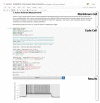Pandemic Teaching: Using the Allen Cell Types Database for Final Semester Projects in an Undergraduate Neurophysiology Lab Course
- PMID: 35540944
- PMCID: PMC9053425
Pandemic Teaching: Using the Allen Cell Types Database for Final Semester Projects in an Undergraduate Neurophysiology Lab Course
Abstract
We designed a final semester research project that allowed students to apply the electrophysiological concepts they learned in a lab course to propose and answer experimental questions without access to laboratory equipment. We created the activity based on lesson plans from Ashley Juavinett and the Allen Institute for Brain Science (AIBS) Allen SDK online examples. An interactive graphic interface was added for students to explore and easily quantify subtle neuronal voltage changes. Before starting the final project, students had experience with conventional extracellular and intracellular recording techniques to record and analyze extracellular action potential firing patterns and intracellular resting, action, and synaptic potentials. They demonstrated their understanding of neural signal transmission in required lab reports using data they gathered before the pandemic shutdown. After students left campus, they continued to analyze data and write lab reports focused on neuronal excitability in snail and fly neurons with data supplied by the instructors. For their final project, students were challenged to answer questions addressing neuronal excitability at both the single neuron and neuronal population level by analyzing and interpreting the open-access, patch clamp recording data from the Allen Cell Types Database using code we provided (Python/Jupyter Notebook). This virtual final semester project allowed students to ask real-world medical and scientific questions from "start to end". Through this project, students developed skills to navigate an extensive online database and gained experience with coding-based data analysis. They chose neuronal populations from human and mouse brains to compare passive properties and neuronal excitability between and within brain areas and across different species and disease states. Additionally, students learned to do simple manipulations of Python code, work remotely in teams, and polish their written scientific presentation skills. This activity could complement other remote learning options such as neuronal simulations. Few online sources offer such a wealth of neuroscience data that students can use for class assignments, and even for research and keystone projects. The activity extends the traditional material often taught in upper-level neuroscience courses, with or without a laboratory section, providing a deeper understanding of the range of excitability properties that neurons express.
Keywords: Allen Cell Types Database; Allen Institute for Brain Science; Jupyter Notebooks; Python; coding; electrophysiology; open access database.
Copyright © 2021 Faculty for Undergraduate Neuroscience.
Figures












Similar articles
-
Learning How to Code While Analyzing an Open Access Electrophysiology Dataset.J Undergrad Neurosci Educ. 2020 Dec 31;19(1):A94-A104. eCollection 2020 Fall. J Undergrad Neurosci Educ. 2020. PMID: 33880096 Free PMC article.
-
Effectiveness of an "online + in-person" hybrid model for an undergraduate molecular biology lab during COVID-19.Biochem Mol Biol Educ. 2023 Mar;51(2):155-163. doi: 10.1002/bmb.21704. Epub 2022 Dec 29. Biochem Mol Biol Educ. 2023. PMID: 36579716
-
A structured-inquiry approach to teaching neurophysiology using computer simulation.J Undergrad Neurosci Educ. 2012 Fall;11(1):A132-8. Epub 2012 Oct 15. J Undergrad Neurosci Educ. 2012. PMID: 23494064 Free PMC article.
-
Project-based learning through sensor characterization in a musical acoustics course.J Acoust Soc Am. 2022 Sep;152(3):1932. doi: 10.1121/10.0014171. J Acoust Soc Am. 2022. PMID: 36182282 Review.
-
Science of the Van Allen Probes Science Operations Centers.Space Sci Rev. 2022;218(8):66. doi: 10.1007/s11214-022-00919-x. Epub 2022 Nov 16. Space Sci Rev. 2022. PMID: 36407497 Free PMC article. Review.
Cited by
-
Integrating Programming into Neuroscience Courses.J Undergrad Neurosci Educ. 2024 Jul 21;22(2):A99-A103. doi: 10.59390/PYYP5010. eCollection 2024 Winter. J Undergrad Neurosci Educ. 2024. PMID: 39280707 Free PMC article.
-
An In-depth Exploration of the Interplay between fMRI Methods and Theory in Cognitive Neuroscience.J Undergrad Neurosci Educ. 2024 Aug 31;22(3):A273-A288. doi: 10.59390/ZABM1739. eCollection 2024 Spring. J Undergrad Neurosci Educ. 2024. PMID: 39355664 Free PMC article.
-
Mapping Human Neuronal Diversity in the Search for New Therapeutics: Using Real Human Neuron Data Sets to Build Student Quantitative Skills.J Undergrad Neurosci Educ. 2023 Dec 17;22(1):A66-A73. doi: 10.59390/OGTZ5579. eCollection 2023 Fall. J Undergrad Neurosci Educ. 2023. PMID: 38322396 Free PMC article.
-
Continued Challenges for Neuroscience Education During the COVID-19 Pandemic.J Undergrad Neurosci Educ. 2021 Dec 24;20(1):E12. eCollection 2021 Fall. J Undergrad Neurosci Educ. 2021. PMID: 35540953 Free PMC article. No abstract available.
-
Effective Development of a Remote Full-Day Summer Neuroscience Program at the University of Pennsylvania.J Undergrad Neurosci Educ. 2022 Oct 1;20(3):A332-A345. doi: 10.59390/PDWF1446. eCollection 2022 Spring. J Undergrad Neurosci Educ. 2022. PMID: 39036714 Free PMC article.
References
-
- Allen Institute for Brain Science. Allen Cell Types Database. 2015a. Available at http://celltypes.brain-map.org/data.
-
- Allen Institute for Brain Science. Allen SDK. 2015b. Available at http://allensdk.readthedocs.io/en/latest/
-
- Allen Institute for Brain Science. Allen SDK examples. 2015c. Available at http://alleninstitute.github.io/AllenSDK/_static/examples/nb/cell_types.....
-
- Allen Institute. Education Outreach. 2021. Available at https://alleninstitute.org/about/education-outreach/
-
- Akyıldız ST. College students’ views on the pandemic distance education: A focus group discussion. Int J Tech Edu Sci (IJTES) 2020;4(4):322–334.
LinkOut - more resources
Full Text Sources
Research Materials
Miscellaneous
